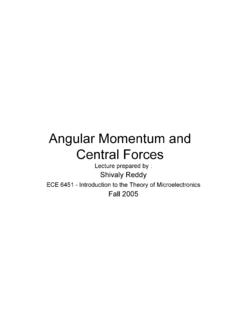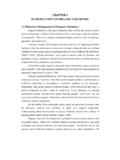Transcription of arXiv:1909.00881v2 [hep-th] 8 Sep 2019 dark matter.
1 The Speed of Gravity [hep-th] 8 Sep 2019. Claudia de Rham & Andrew J. Tolley Theoretical Physics, Blackett Laboratory, Imperial College, London, SW7 2AZ, UK. CERCA, Department of Physics, Case Western Reserve University, 10900 Euclid Ave, Cleveland, OH 44106, USA. E-mail: Abstract: Within the standard effective field theory of General Relativity, we show that the speed of gravitational waves deviates, ever so slightly, from luminality on cosmological and other spontaneously Lorentz breaking backgrounds. This effect results from loop contributions from massive fields of any spin, including Standard Model fields, or from tree level effects from massive higher spins s 2. We show that for the choice of interaction signs implied by S matrix and spectral density positivity bounds suggested by analyticity and causality, the speed of gravitational waves is in general superluminal at low energies on NEC preserving backgrounds, meaning gravitational waves travel faster than allowed by the metric to which photons and Standard Model fields are minimally coupled.
2 We show that departure of the speed from unity increases in the IR and argue that the speed inevitably returns to luminal at high energies as required by Lorentz invariance. Performing a special tuning of the EFT. so that renormalization sensitive curvature squared terms are set to zero, we find that finite loop corrections from Standard Model fields still lead to an epoch dependent modification of the speed of gravitational waves which is determined by the precise field content of the lightest particles with masses larger than the Hubble parameter today. Depending on interpretation, such considerations could potentially have far reaching implications on light scalar models, such as axionic or fuzzy cold dark matter. Contents 1 Introduction 1. 2 Effects of Heavy modes on Gravity at Low Energy 5. Effective Field theory for Gravity at Low energy 5. A Word of Caution on Field Redefinitions 9. Relevance of the Dimension 6 Curvature Operators 10.
3 3 Tensor Modes on a Background, Leading EFT Corrections 10. Identifying Speeds in an EFT Context 11. Reorganizing EFT expansion 11. Identifying the Speed 12. Curvature Squared Corrections on FLRW 13. Static Warped Geometries 16. Sound Speed Frequency Dependence 17. 4 Superluminality & Causal UV Completions 18. Gravity versus Matter light cones and Null Energy Condition 18. Positivity Bounds for Light Fields 21. T T amplitude 23. Weakly Coupled UV Completion 23. Generic UV Completion 25. Neglecting the t Channel Pole 26. Higher Derivative Corrections 27. EFT matching 27. Curvature Couplings to Light Fields 28. 5 Effects from Higher Dimension Curvature Operators 31. Dimension 6 Curvature Operators 32. One Loop Effective Action 32. Dimension 6 Curvature Operators on FLRW 33. Modification of the Dispersion Relation 33. Field Content Dependence 34. Dimension 8 Curvature Operators 37. 6 Discussion 38.
4 A One Loop Effective Action 41. Minimally Coupled Scalar Field 41. Dimensional Regularization 42. Perturbative 1 Loop Contributions 43. Graviton One Point Function 43. Graviton Two Point Function 43. Graviton Three Point Function 44. i . B Tensor Modes on FLRW from Dimension 6 Operators 46. C Resumming Green's Function Secular Behaviour 49. 1 Introduction In this new era of gravitational wave astronomy, it is especially important to understand how gravita- tional waves propagate. The recent simultaneous observation of gravitational waves from the coales- cence of two neutron stars, GW170817, together with its gamma ray counterpart, GRB 170817A, has put the cleanest constraint on the propagation speed of gravitational waves relative to photons, [1 3]. In classical General Relativity minimally coupled to matter, gravitational waves always travel luminally, as defined by the lightcones of the metric g with respect to which matter is coupled, by virtue of the equivalence principle.
5 For instance, when considering the propagation of linearized grav- itational waves across some general curved background geometry, the background metric may always be put in a Riemann normal coordinate system where it is locally Minkowski in the vicinity of a space- time point x, plus curvature corrections that grow away from x. Since the Einstein Hilbert action is second order, modifications from the background curvature terms to the propagation of gravitational waves on this background can only arise as an effective mass term (simply from power counting deriva- tives), and never as corrections to the kinetic or gradient terms. For example, in FLRW spacetime, gravitational waves have an effective mass' from the background expansion of order H 2 , H, 9 in terms of the Hubble parameter H, but their sound speed defined by the ratio of kinetic to gradient terms is luminal1 . Hence it is the two derivative nature of Einstein's theory , together with diffeomorphism invariance, that guarantees luminality in General Relativity.
6 Classical General Relativity is not however the real world. At a minimum, gravitational effects generated from quantum loops of known particles, the electron, will already generate modifi- cations to Einstein gravity which alter this process. Many of these effects are finite (meaning free from renormalization ambiguities) and calculable. These effects are of course highly suppressed, being induced by loops, but any potential departure of the speed of propagation of gravitational waves from luminality is itself significant, not least because it impacts our understanding of the causal structure of a given theory . Various proposed extensions to four dimensional General Relativity, such as extra dimension models, or string theory , will also induce modifications to the Einstein Hilbert Lagrangian that can potentially change the above picture. The general framework to account for such corrections is well understood and goes under the umbrella of Effective Field theory for Gravity' [4 7] (for a recent example of this methodology, see a00 2.)
7 1 Canonically ~ 2+. d d3 x 12 h02 ( h). R. normalized tensor fluctuations in GR have quadratic action SGR = a h . Despite the effective mass' a00 /a the actual mass is zero. In the well known case of the propagation of gravitational waves during inflation, this effective mass is negative, and drives an instability which generates long wavelength scale invariant tensor fluctuations, but the retarded propagator vanishes outside the lightcone defined by cs = 1. In what follows, in FLRW we define the speed via the lightcone of the effective metric on which modes propagate, via cs in ~ 2 m2 h2 , so the effective mass does not play a role in the definition of the the action Shh = d d3 x 21 h02 c2s ( h). R. eff speed. 1 . [8]). Historical issues with non renormalizability and the artificial separation of quantum fields on curved spacetimes are replaced with the general effective field theory (EFT) framework that allows us, if desired, to simultaneously quantize matter and gravity despite the non renormalizability of the Lagrangian.
8 The price to pay is the need to introduce an infinite number of counterterms, but in practice at low energies only a finite number are ever relevant. The low energy effective theory is defined an effective Lagrangian valid below some scale E M which accounts for all tree and loop level corrections from particles of masses greater or equal to M , and loop processes of light fields at energies greater than M 2 . The starting point is then the Wilsonian action which includes all possible covariant operators build out of the Riemann tensor, its derivatives, and combinations of light fields and their derivatives. For instance, assuming no other light fields than gravity, the leading corrections are powers of curvature and derivatives thereof, very schematically . " n #. 2. 4 . Z. MPl 2 2 2. X Cn,p X 2p 2+n p SEFT = d x g + R + C1 R + C2 R + C3 R + 2n Riem , 2 n=1. MPl p=0. where by 2p Riem2+n p we mean all possible scalar local operators constructed out of contractions of this number of powers of Riemann tensor and covariant derivatives.
9 The precise energy scale of 2n suppression Cn,p /MPl will depend on the origin of a given term, it will in general be different for interactions coming from tree level processes or from loops. In general there is not one such EFT, but a family of them depending on the choice of scale M above which physics has been integrated out. Even in the absence of matter, the speed of gravitational waves is modified by the addition of higher curvature terms, precisely because the earlier argument based on power counting of derivatives is no longer valid. Higher derivative curvature terms can, and do, modify the second order derivative terms in the equation for propagation when expanding around a background. Since gravitational waves are luminal in pure GR, the sign of higher curvature terms will typically lead the resulting corrections to make the waves either superluminal or subluminal. Typically causality is imposed by demanding that the modified gravitational waves are subluminal (with respect to the lightcone defined by the metric g , based on similar arguments for scalar fields [9, 10], hence fixing the signs for the higher curvature coefficients.)
10 For instance for Ricci flat backgrounds this is done in [11] for quartic curvature corrections of the type that arise in the low energy EFT from string theory . Within the context of the EFTs of inflation/dark energy, where matter sources the background, a potential modification to the speed of gravitational waves has been noted in [12 14]. More generally this procedure of demanding subluminality of all fluctuations is problematic be- cause in a gravitational EFT the metric itself is ambiguous (see [15] for related discussions). It is always possible to perform fields redefinitions, schematically of the form X n,p 2p Riemn , . g g + 2(n+p). ( ). p,n MPl where 2p Riemn is a tensor constructed out of n contractions of Riemann and 2p covariant . derivatives, which leave invariant the leading Einstein Hilbert term. Those are consistent with the gravitational EFT, but modify the lightcone of the metric.
![arXiv:0706.3639v1 [cs.AI] 25 Jun 2007](/cache/preview/4/1/3/9/3/1/4/b/thumb-4139314b93ef86b7b4c2d05ebcc88e46.jpg)

![arXiv:1301.3781v3 [cs.CL] 7 Sep 2013](/cache/preview/4/d/5/0/4/3/4/0/thumb-4d504340120163c0bdf3f4678d8d217f.jpg)
![@google.com arXiv:1609.03499v2 [cs.SD] 19 Sep 2016](/cache/preview/c/3/4/9/4/6/9/b/thumb-c349469b499107d21e221f2ac908f8b2.jpg)









